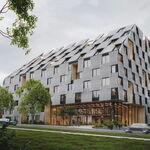you need to realize that this is a pilot project, so it's limited by the fact that it needs to be reversible.
Yes, it's "reversible". That's the problem and the challenge.
it's meant to show us that the final solution is going to work.
In a half-assed approach stifled from the systems other cities use...*PILOT OR NOT*? Like intelligent priority signalling systems for transit...
The changes on King are working really well.
By what measure? There's been some promising incremental improvement, nothing like the radical improvement claimed by some. I wouldn't want you playing on my team. You'd be declaring victory before the struggle had finished, and then wasting energy on celebrating before the victory was achieved.
in all likelihood there will be a vote to make this permanent
lol...not at this rate! There's some serious issues to confront, *even if they are baseless* like the claims of lost business. Moneris might have a few surprises. Only a fool would slack off at this point in time. When the Star headlines like it has, you know this isn't a slam-dunk.
the irreversible changes can start happening.
The changes can start happening now for Gawdsakes. Like investing in a *world class* signalling system that not only gives transit priority, it does so on an advanced algorithm determined basis, fully re-progammable remotely for changing weather conditions, events, weekends, vehicle substitution and accidents. And *experiments* to optimize the parameters used.
That is needed NOW...Pilot alive or dead. How could you possibly argue against *equipping* the Pilot for "Proof of Concept" when according to you, it's going to be needed inevitably anyway?
'Johnny has no shoes. Let's not buy them now, because we know he's going to have them in a year's time and I'm sure he's going to live'.
And needless to say, except for some, the signalling system will be equipped with Red Light Cameras at every major intersection. The City itself sings the praises of doing so. Best it start singing in tune. It called the pitch...bad enough it can't remember the words...
 Screen Shot 2017-12-22 at 9.31.02 PM.png32.8 KB · Views: 473
Screen Shot 2017-12-22 at 9.31.02 PM.png32.8 KB · Views: 473 Screen Shot 2017-12-22 at 9.30.41 PM.png32.8 KB · Views: 458
Screen Shot 2017-12-22 at 9.30.41 PM.png32.8 KB · Views: 458 Screen Shot 2017-12-22 at 9.31.18 PM.png30.1 KB · Views: 499
Screen Shot 2017-12-22 at 9.31.18 PM.png30.1 KB · Views: 499 Screen Shot 2017-12-22 at 9.30.53 PM.png30.2 KB · Views: 465
Screen Shot 2017-12-22 at 9.30.53 PM.png30.2 KB · Views: 465 Screen Shot 2017-12-22 at 9.40.23 PM.png29.7 KB · Views: 455
Screen Shot 2017-12-22 at 9.40.23 PM.png29.7 KB · Views: 455





